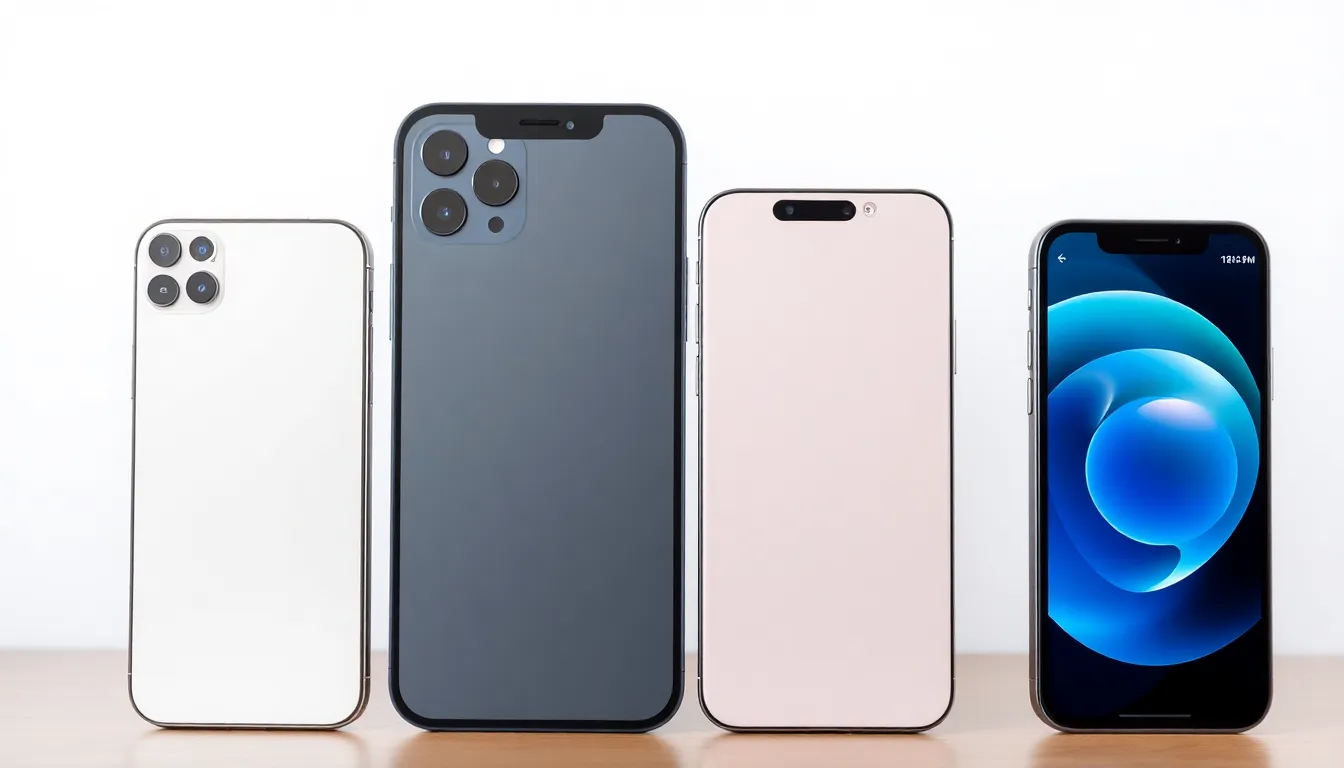When it comes to iPhones, size matters—at least for those who want a screen big enough to binge-watch their favorite shows without squinting. Apple’s lineup has something for everyone, but if you’re on the hunt for the biggest iPhone, you’re in for a treat. Imagine holding a device that feels more like a mini tablet than a phone.
In a world where bigger often means better, the latest models are pushing the limits of what a smartphone can be. Whether you’re an avid gamer or just someone who loves scrolling through social media with ease, knowing which iPhone reigns supreme in size can make all the difference. So let’s dive into the details and uncover which iPhone is the biggest, because who wouldn’t want to flaunt the king of smartphones?
Table of Contents
ToggleOverview of iPhone Sizes
Apple offers a range of iPhone sizes, catering to various user preferences and needs. The iPhone lineup includes models from compact to sizable, reflecting diverse consumer demands. Historically, larger iPhones have become increasingly popular for their immersive experiences.
Current offerings feature several sizes, including the iPhone 15 Pro Max, which boasts a 6.7-inch display, marking one of the largest screens available. Users seeking maximum viewing real estate often opt for this model. The iPhone 14 Pro Max also features a 6.7-inch screen, providing a similar user experience to its successor.
In addition to the Pro Max models, Apple includes the iPhone 15 and iPhone 15 Plus, measuring 6.1 and 6.7 inches respectively. While these sizes cater to users who prefer a balance between screen size and portability, those favoring larger screens tend to lean towards the Pro Max variants.
Apple’s focus on larger screens enhances activities like gaming and streaming. More screen space means better visibility and a richer visual experience. With advancements in display technology, newer models provide vibrant colors and sharp graphics, appealing especially to mobile gamers.
Overall, the variety in iPhone sizes ensures users can find a device that meets their unique preferences. Significant options like the iPhone 15 Pro Max lead the pack regarding size, establishing a standard for large-screen smartphones. Users now enjoy a range of choices that enhance their daily digital interactions.
Historical Comparison of iPhone Sizes

The evolution of iPhone sizes demonstrates Apple’s focus on user preferences over time. Early models such as the iPhone 4 featured a compact 3.5-inch screen, catering to portability. Users embraced the sleek design, making it popular among those seeking convenience over size.
Recent models show a stark contrast in dimensions. The iPhone 13 Pro Max and iPhone 14 Pro Max each offer a 6.7-inch display, appealing to consumers who prioritize larger screens for gaming or streaming. Alongside these, the iPhone 15 series maintained the trend with similar sizes. Smaller options, like the iPhone 15, provide flexibility while still addressing varying user needs. The impressive growth in screen size reflects changing usage patterns, with larger displays now considered essential for enhanced user experiences.
What iPhone Is the Biggest Size?
The largest iPhone currently available is the iPhone 15 Pro Max. This model features an expansive display that significantly enhances multimedia experiences.
Overview of Current Largest Model
The iPhone 15 Pro Max boasts a 6.7-inch Super Retina XDR display, providing vibrant colors and large viewing areas. It offers advanced features such as ProMotion technology, delivering improved responsiveness and smooth scrolling. Limited to a specific user experience, it caters especially well to gamers and media enthusiasts seeking high-resolution visuals. With this larger model, Apple continues to prioritize user engagement with its devices, supporting both productivity and entertainment seamlessly.
Physical Dimensions and Specifications
In terms of physical dimensions, the iPhone 15 Pro Max measures 6.33 inches in height, 3.05 inches in width, and 0.31 inches in depth. Designed for comfort, it weighs approximately 8.47 ounces, making it slightly heavier than its predecessors. The device includes a glass back and a stainless steel frame, ensuring durability without sacrificing style. It’s engineered to accommodate advanced features, including a powerful A17 Pro chip and extensive camera capabilities, further emphasizing the importance of size in delivering a superior user experience.
User Experience with Larger iPhones
Larger iPhones enhance user experiences significantly, particularly for activities that require enhanced visibility and interaction.
Pros and Cons of Larger Sizes
Larger sizes offer numerous advantages. Greater screen real estate allows for immersive gaming and streaming experiences. Quick scrolling and easy navigation become standard features on these expansive displays. On the downside, portability may present challenges. Fitting a larger device in pockets can be cumbersome. Handling a bigger iPhone with one hand might prove difficult for some users. Overall, weighing the benefits against potential drawbacks helps users make informed decisions.
Popularity Among Users
User preference for larger iPhones continues to rise. Recent sales data indicates that models like the iPhone 15 Pro Max and iPhone 14 Pro Max dominate purchase trends. Many users prioritize visual experiences, fueling the demand for expansive screens. Studies show that users favor larger displays for gaming and media consumption. As Apple continues to innovate, this trend is likely to persist. The integration of advanced display technologies boosts user satisfaction, reinforcing the appeal of larger iPhones.
The iPhone 15 Pro Max stands out as the largest model in Apple’s lineup, offering a 6.7-inch display that elevates multimedia experiences. Its advanced features cater to users who prioritize gaming and streaming, making it an attractive choice for those seeking enhanced visibility and interaction.
As preferences shift towards larger screens, the iPhone 15 Pro Max showcases how Apple adapts to meet user demands. The growing popularity of larger devices reflects a broader trend in mobile technology, with consumers increasingly valuing immersive experiences. With ongoing innovations in display technology, the future of iPhones promises even more exciting developments for users who crave bigger screens.


